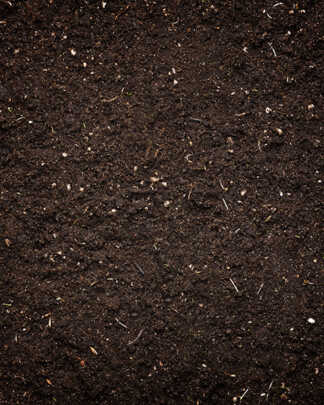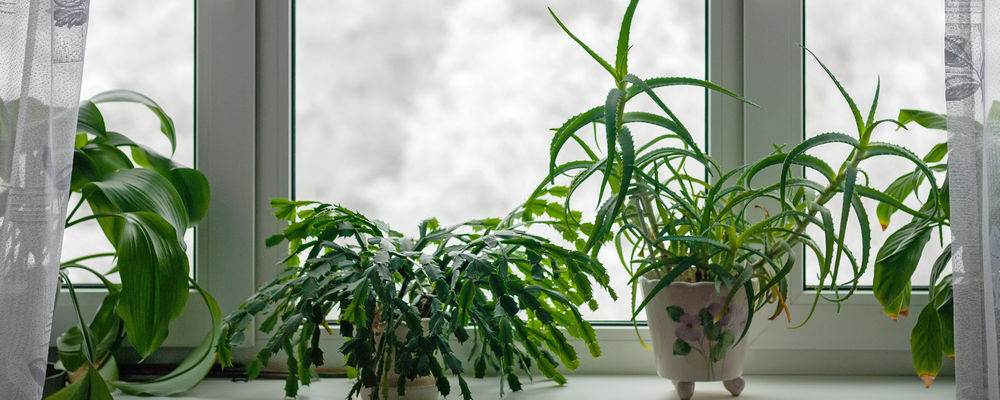
Winterizing Your Houseplants
Do you really need to winterize your indoor houseplants? This is a question we’ve been hearing quite often in recent months, especially with the surge of new plant parents – folks who are doing the responsible thing by staying close to home during the pandemic.
Back to the question, and the answer is: YES!
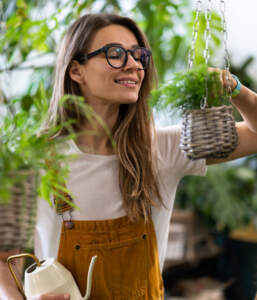
Don’t worry about having to invest lots of time to keep your plants looking their best during this season. We’ve simplified the process for you. Just read on to get Winter Ready! Our goal is to help your plants thrive now so when spring returns, you’ll be rewarded with new growth.
Let’s begin by discussing what “winterizing” actually means. Simply stated, it is the act of planning for plant care during the winter months. And, let’s be clear, winterizing is NOT only for outdoor tropical plants. As the days get shorter and temperatures begin to drop, it’s especially important to start taking cues from your plants and noting how they react to seasonal changes. Temperatures can fluctuate dramatically from warmer days to colder temps at night. As you turn on the heat, the drier indoor air means you must adjust your watering schedule and provide increased humidity. We want to underscore the most important factors in successfully winterizing your plants are proper lighting, watering, and maintaining optimum humidity levels.
Lighting
For East Coast residents in New York, New Jersey, etc., daylight can end as early as 4:30 pm. This limits the amount of light coming into your home. As you know, plants require light for photosynthesis, which provides much-needed energy to grow, bloom, and, if applicable, produce seeds.
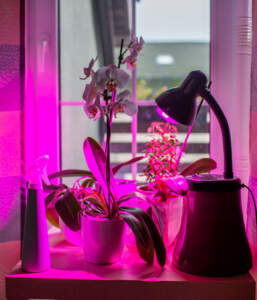
Not all plants require the same lighting conditions. Plants such as a Monstera Deliciosa, Sansevieria, ZZ plant, etc., will thrive in low light. On the other hand, popular favorites such as Fiddle Leaf Fig, Pony Tail Palm and Areca Palm may need an additional light source to help compensate for winter’s lower light conditions.
Grow Lights. We’ve all heard about them, but do you really need them? The answer is yes and no. If your plants can thrive in low light, like those listed above, there’s no need. However, if you have sun loving plants, then yes! Interestingly, you need not turn on your grow light every day. Once or twice during the week for a few hours each time is all your plants may need.
With so many lights on the market, it can be confusing to select the right one. We done our research and spoken to a few experts and recommend a full spectrum LED grow light with 6500 Kelvins. Our favorite lights are those you can buy as a bulb and switch out into an existing light fixture for several hours at a time. When using your grow lights throughout the week, we always suggest grouping your light loving plants together so they can enjoy the additional artificial light together.
Watering
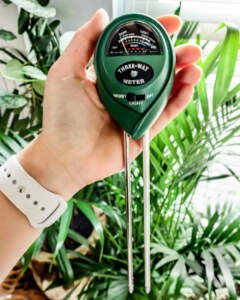
Watering, by far, must be the hardest concept to teach any plant parent. Luckily, with trial and error, proper watering techniques can be mastered. During the winter, as plants receive less light, they will drink less – meaning their watering schedules should be adjusted. Always keep in mind you must NOT overwater, as this can lead to root rot. Your challenge is to ensure plants that require evenly moist soil never get their soil too soggy. We always recommend using a moisture meter – at any time of year – to assist with your watering routine.
Luckily for you, we now carry one of the most popular moisture meters on the market. Our 3-in-1 Moisture, Light, & PH Meter is the perfect tool to test the amount of water your plants are receiving. This easy to use meter requires no batteries, and is perfect for indoor or outdoor plants. To get your very own moisture meter, or to send one as a gift, click here.
Humidity
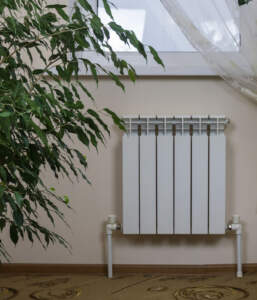
As you turn on the indoor heat, you’ll probably notice drier environments in your home. Your skin begins to feel drier to the touch. Drier air environments also affect your humidity loving tropical plants. NEVER place plants near furnaces or radiators when these are in use, as this causes leaf burn.
There are two ways to supplement the humidity levels in your home:
- Misting – Simply fill your favorite spray bottle with water and mist away! Mist both the topsoil of your plants and also spritz the foliage a bit each day.
- Humidifiers – There are many humidifiers on the market. You’ll need to consider the variables of your plant collection and room size. Running your humidifier a few hours each day will provide the extra moisture your plants need, and it benefits your skin, as well. You may even want to consider adding some essential oils to the humidifier for a bit of self indulgence.
Please remember that if you have plants that require more attention, like Ferns or Calathea, you’ll want to mist these daily, even if you are running a humidifier. Be careful to ensure their soil is evenly moist and not soggy.
Additional Winterizing Topics: Repotting, Fertilizing, Windows, Drafts and More!
- Repotting – A hot debate topic is whether to repot during winter months. The answer is: Not Necessary. During winter months, your plants grow more slowly than in the summer. However, if you see that one of your plants is essentially busting out of its existing pot, you can repot, but it is not urgent to do so.
- Fertilizing – During the winter season, it is also not necessary to fertilize your plants since growth is slower. If you choose to fertilize, dilute your fertilizer to avoid stressing the plant.
- Windows – Keeping plants in treasured window sills during winter months can actually do more harm than good. Just as windows emit heat during the warmer months, they also emit cold during the winter. To avoid cold damage, keep plants off the window sill.
- Drafts – Be mindful of keeping plants out of direct drafts. These can cause leaf drop in plants like the Weeping Fig. Drafts can also cause “crispy leaves,” due to constant hot air flow hitting the foliage.
Your Questions Answered from Instagram:
@itsgigirobinson – Grow lights? Misting? – During the winter, it is very important to create an environment that is not dry. We recommend using a humidifier or the misting technique described above to keep your plants happy. Grow lights are important for bright light-loving plants, but they should only be used a few times per week. Our favorite grow lights are ones you can screw into existing fixtures in your home. These will not compromise the aesthetics of your home. Your grow light should be a full spectrum LED light.
@krissy_drake – How to adjust watering for plants that droop or like moist topsoil? – It is important to use a moisture meter for plants that prefer evenly moist soil. Remember to also mist their topsoil daily, as you would normally do. For plants that prefer evenly moist soil, such as Prayer Plants or Ferns, make sure to never let them get soggy or dried out.
@ruby_top_of-the_hills – I live in NJ and keep plants by windows in warm months. Should I move them away from windows due to cold? – The answer depends on how close your plants are to the window. If the plants are touching the window, then yes, move them so they will not get cold burn (which results in black spots on the foliage). Many tropical houseplants do not tolerate temperatures below 35-40 degrees Fahrenheit.
@poydiamante – Winter is Coming!!! Can you suggest a good grow light for large BOP and Monsteras? – Definitely! No matter what you choose, a full spectrum LED light will do just fine. @thejungleupstairs recently collaborated with us and shared her winterizing tips for her New York apartment. She recommended this Sansi Grow Light. You can watch her winterizing tips in our IG highlights by clicking here.
@wackypaki – Watering techniques with actual pours? – Coming soon to a video near you! 😛
@dbdoll – How to take care of my Monstera during the winter months in New York? – Great question! Luckily for you, Monstera can tolerate low light conditions. It is important to adjust watering to avoid overwatering. You should also provide additional humidity by misting the top soil and leaves, or by using a humidifier. Using a grow light is optional for this BB as it tolerates low light.
@padma.govind – Can you re-pot in the winter? Noticed a terribly root bound Dracaena! – If you think it cannot wait, then go ahead. Most likely, there will be not much growth happening during the next few months, so repotting is completely up to you.
Winterizing Your Houseplants
Do you really need to winterize your indoor houseplants? This is a question we’ve been hearing quite often in recent months, especially with the surge of new plant parents – folks who are doing the responsible thing by staying close to home during the pandemic.
Back to the question, and the answer is: YES!

Don’t worry about having to invest lots of time to keep your plants looking their best during this season. We’ve simplified the process for you. Just read on to get Winter Ready! Our goal is to help your plants thrive now so when spring returns, you’ll be rewarded with new growth.
Let’s begin by discussing what “winterizing” actually means. Simply stated, it is the act of planning for plant care during the winter months. And, let’s be clear, winterizing is NOT only for outdoor tropical plants. As the days get shorter and temperatures begin to drop, it’s especially important to start taking cues from your plants and noting how they react to seasonal changes. Temperatures can fluctuate dramatically from warmer days to colder temps at night. As you turn on the heat, the drier indoor air means you must adjust your watering schedule and provide increased humidity. We want to underscore the most important factors in successfully winterizing your plants are proper lighting, watering, and maintaining optimum humidity levels.
Lighting
For East Coast residents in New York, New Jersey, etc., daylight can end as early as 4:30 pm. This limits the amount of light coming into your home. As you know, plants require light for photosynthesis, which provides much-needed energy to grow, bloom, and, if applicable, produce seeds.

Not all plants require the same lighting conditions. Plants such as a Monstera Deliciosa, Sansevieria, ZZ plant, etc., will thrive in low light. On the other hand, popular favorites such as Fiddle Leaf Fig, Pony Tail Palm and Areca Palm may need an additional light source to help compensate for winter’s lower light conditions.
Grow Lights. We’ve all heard about them, but do you really need them? The answer is yes and no. If your plants can thrive in low light, like those listed above, there’s no need. However, if you have sun loving plants, then yes! Interestingly, you need not turn on your grow light every day. Once or twice during the week for a few hours each time is all your plants may need.
With so many lights on the market, it can be confusing to select the right one. We done our research and spoken to a few experts and recommend a full spectrum LED grow light with 6500 Kelvins. Our favorite lights are those you can buy as a bulb and switch out into an existing light fixture for several hours at a time. When using your grow lights throughout the week, we always suggest grouping your light loving plants together so they can enjoy the additional artificial light together.
Watering

Watering, by far, must be the hardest concept to teach any plant parent. Luckily, with trial and error, proper watering techniques can be mastered. During the winter, as plants receive less light, they will drink less – meaning their watering schedules should be adjusted. Always keep in mind you must NOT overwater, as this can lead to root rot. Your challenge is to ensure plants that require evenly moist soil never get their soil too soggy. We always recommend using a moisture meter – at any time of year – to assist with your watering routine.
Luckily for you, we now carry one of the most popular moisture meters on the market. Our 3-in-1 Moisture, Light, & PH Meter is the perfect tool to test the amount of water your plants are receiving. This easy to use meter requires no batteries, and is perfect for indoor or outdoor plants. To get your very own moisture meter, or to send one as a gift, click here.
Humidity

As you turn on the indoor heat, you’ll probably notice drier environments in your home. Your skin begins to feel drier to the touch. Drier air environments also affect your humidity loving tropical plants. NEVER place plants near furnaces or radiators when these are in use, as this causes leaf burn.
There are two ways to supplement the humidity levels in your home:
- Misting – Simply fill your favorite spray bottle with water and mist away! Mist both the topsoil of your plants and also spritz the foliage a bit each day.
- Humidifiers – There are many humidifiers on the market. You’ll need to consider the variables of your plant collection and room size. Running your humidifier a few hours each day will provide the extra moisture your plants need, and it benefits your skin, as well. You may even want to consider adding some essential oils to the humidifier for a bit of self indulgence.
Please remember that if you have plants that require more attention, like Ferns or Calathea, you’ll want to mist these daily, even if you are running a humidifier. Be careful to ensure their soil is evenly moist and not soggy.
Additional Winterizing Topics: Repotting, Fertilizing, Windows, Drafts and More!
- Repotting – A hot debate topic is whether to repot during winter months. The answer is: Not Necessary. During winter months, your plants grow more slowly than in the summer. However, if you see that one of your plants is essentially busting out of its existing pot, you can repot, but it is not urgent to do so.
- Fertilizing – During the winter season, it is also not necessary to fertilize your plants since growth is slower. If you choose to fertilize, dilute your fertilizer to avoid stressing the plant.
- Windows – Keeping plants in treasured window sills during winter months can actually do more harm than good. Just as windows emit heat during the warmer months, they also emit cold during the winter. To avoid cold damage, keep plants off the window sill.
- Drafts – Be mindful of keeping plants out of direct drafts. These can cause leaf drop in plants like the Weeping Fig. Drafts can also cause “crispy leaves,” due to constant hot air flow hitting the foliage.
Your Questions Answered from Instagram:
@itsgigirobinson – Grow lights? Misting? – During the winter, it is very important to create an environment that is not dry. We recommend using a humidifier or the misting technique described above to keep your plants happy. Grow lights are important for bright light-loving plants, but they should only be used a few times per week. Our favorite grow lights are ones you can screw into existing fixtures in your home. These will not compromise the aesthetics of your home. Your grow light should be a full spectrum LED light.
@krissy_drake – How to adjust watering for plants that droop or like moist topsoil? – It is important to use a moisture meter for plants that prefer evenly moist soil. Remember to also mist their topsoil daily, as you would normally do. For plants that prefer evenly moist soil, such as Prayer Plants or Ferns, make sure to never let them get soggy or dried out.
@ruby_top_of-the_hills – I live in NJ and keep plants by windows in warm months. Should I move them away from windows due to cold? – The answer depends on how close your plants are to the window. If the plants are touching the window, then yes, move them so they will not get cold burn (which results in black spots on the foliage). Many tropical houseplants do not tolerate temperatures below 35-40 degrees Fahrenheit.
@poydiamante – Winter is Coming!!! Can you suggest a good grow light for large BOP and Monsteras? – Definitely! No matter what you choose, a full spectrum LED light will do just fine. @thejungleupstairs recently collaborated with us and shared her winterizing tips for her New York apartment. She recommended this Sansi Grow Light. You can watch her winterizing tips in our IG highlights by clicking here.
@wackypaki – Watering techniques with actual pours? – Coming soon to a video near you! 😛
@dbdoll – How to take care of my Monstera during the winter months in New York? – Great question! Luckily for you, Monstera can tolerate low light conditions. It is important to adjust watering to avoid overwatering. You should also provide additional humidity by misting the top soil and leaves, or by using a humidifier. Using a grow light is optional for this BB as it tolerates low light.
@padma.govind – Can you re-pot in the winter? Noticed a terribly root bound Dracaena! – If you think it cannot wait, then go ahead. Most likely, there will be not much growth happening during the next few months, so repotting is completely up to you.

